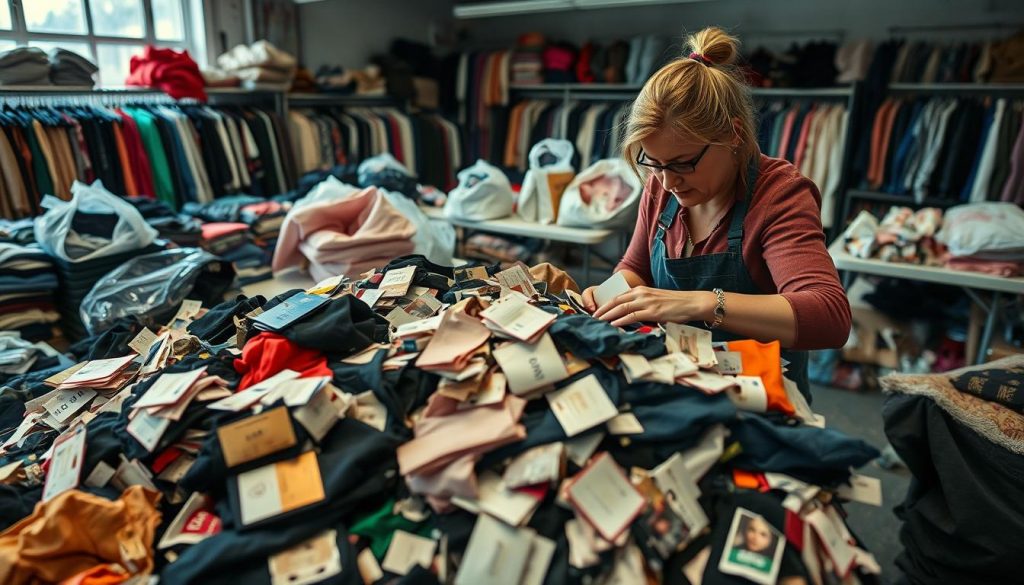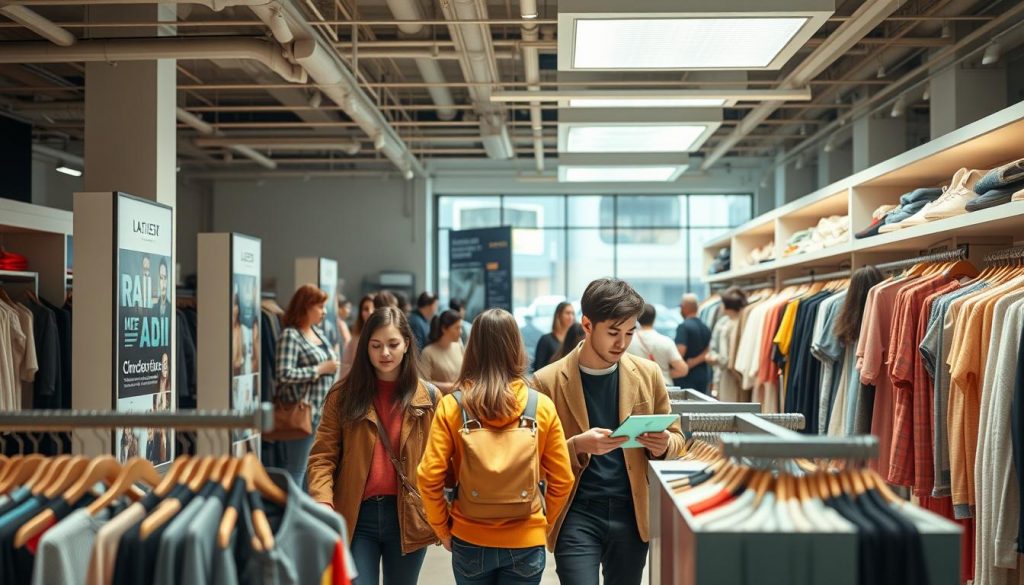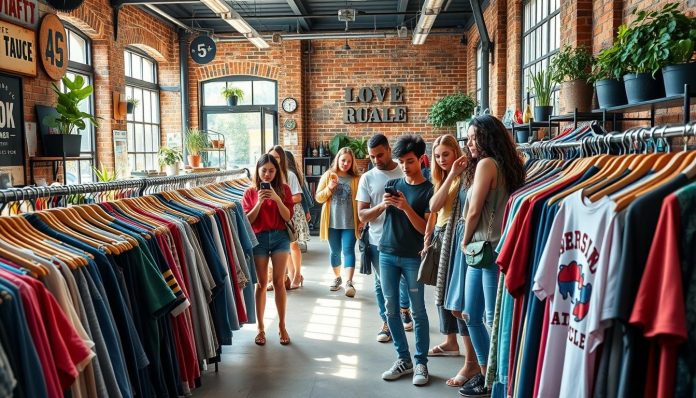The UK fashion landscape is experiencing a remarkable transformation as Generation Z leads a powerful surge in second-hand shopping. What was once considered a fringe activity has evolved into a mainstream movement, with preloved fashion now occupying prime retail spaces and dominating social media feeds. This shift represents more than just a passing trend—it’s a fundamental reimagining of consumption patterns driven by environmental consciousness, economic pressures, and digital connectivity.
Why the Gen Z UK Thrifting Boom Is Happening
The second-hand market in the UK has experienced unprecedented growth, with consumer spending on preloved clothing and footwear reaching £2.4 billion in 2023. According to GlobalData, the clothes resale market grew by a staggering 149% between 2016 and 2022, with projections indicating a further 67.5% rise from 2022 to 2026. This remarkable expansion is being driven by multiple converging factors.
Sustainability Concerns
Environmental awareness is a primary driver behind the Gen Z UK thrifting boom. With the fashion industry responsible for up to 10% of global carbon emissions, young consumers are increasingly rejecting fast fashion’s environmental impact. Alex Goat, chief executive of youth culture consultancy Livity, notes that “wearing second-hand is a demonstrable statement of your intention, and a rejection of one of the most polluting industries on the planet.”
Economic Pressures
The cost-of-living crisis has significantly influenced shopping behaviours across the UK. Thrifting offers substantial savings, with second-hand shoppers spending an average of £91.60 in 2023. Young adults aged 18-34 spent more, averaging £120.40, while Londoners topped the spending at £133.20. These figures reflect how thrifting has become a financial necessity for many, not just an ethical choice.
Social Media Influence
Platforms like TikTok and Instagram have transformed how Gen Z discovers and shares fashion. The hashtag “vintage” alone has amassed 28.7 billion views on TikTok, while thrifting hauls and outfit transformations regularly go viral. This digital ecosystem has removed the stigma once associated with second-hand clothing, instead positioning it as a badge of creativity and individuality.
Gen Z’s Unique Role in the Thrifting Revolution
Generation Z has emerged as the driving force behind the second-hand market’s explosive growth. Research by Boston Consulting Group and resale site Vestiaire revealed that this demographic is most likely to buy (31%) and sell (44%) second-hand items. Depop, a popular resale platform, reports that 90% of its active users are under the age of 26.

Digital Natives Transforming Retail
“Gen Z is a digitally native generation. Their communication, entertainment, and shopping habits are all mobile-first, so it makes sense that this generation is leading the growth of the market,” explains Anthony Marino, president of online second-hand platform Thredup. Their comfort with technology has fuelled the success of platforms like Depop, Vinted, and eBay, which reported that 58% of Gen Z who bought second-hand apparel made at least one purchase online, more than any other generation.
Influencers and Celebrity Impact
The influence of celebrities and fashion leaders has legitimized second-hand shopping. Harry Lambert, the celebrity stylist who works with Harry Styles and Emma Corrin, participated in the Absolut Swap Shop in London, bringing high-fashion credibility to clothes swapping. Meanwhile, Love Island’s partnership with eBay for its second consecutive series has exposed millions of viewers to preloved fashion alternatives.
How the Thrifting Boom Is Reshaping UK Retail
The surge in second-hand shopping is forcing traditional retailers to adapt their business models. According to Thredup, 86% of retail executives acknowledge that their customers are already participating in resale, an 8% increase from 2021. This recognition has led to significant changes in the retail landscape.
High Street Transformation
Perhaps the most visible sign of change is the Charity.Super.Mkt in Brent Cross shopping centre, which now occupies a space that once housed a Topshop. This second-hand department store, masterminded by former Red or Dead designer Wayne Hemingway and Maria Chenoweth, chief executive of Traid, represents how preloved fashion has moved from the fringes to prime retail locations.
Luxury Sector Adaptation
The resale revolution has reached the luxury market as well. Retailers from Selfridges to Net-A-Porter have ventured into resale, while matchesfashion.com has partnered with Reluxe, a site selling preloved designer items. These collaborations have proven remarkably successful, with 90% of the range selling within hours during recent partnerships.
Mainstream Brands Joining the Movement
Middle-market companies such as Cos, Joules, and Toast have started reselling preloved items online alongside their new season collections. This hybrid approach allows established brands to participate in the circular economy while maintaining their primary business models. The children’s wear sector has seen particularly dramatic growth, with second-hand children’s clothes sales projected to increase by 493% in the next decade.
Challenges in the Second-hand Market
Despite its growth, the second-hand market faces several significant challenges that could impact its long-term sustainability and ethical credentials.

The “Thrift Flipping” Controversy
A contentious issue within the community is “thrift flipping”—the practice of buying inexpensive second-hand items to resell at a markup. Critics argue this drives up prices at charity shops and disadvantages lower-income shoppers who rely on affordable second-hand options. Defenders counter that it encourages creative upcycling and extends the lifespan of clothing items.
Fast Fashion’s Resale Problem
Not all second-hand clothing is created equal. Harriet Vocking, chief executive at sustainable strategy consultancy Eco-Age, points out that “the issue is not that resale will become like fast fashion, but rather that fast fashion cannot be resold.” Low-quality items from fast fashion brands often don’t survive multiple wearing’s, limiting their potential in the circular economy.
Unsold Inventory Challenges
Even resale platforms face the challenge of unsold stock. Thredup acknowledges this issue, noting that items that cannot be resold are “either sold through Rescues Boxes or are responsibly reused and recycled through a vetted network of partners such as domestic thrift stores, international brokers, and domestic graders and sorters.” The environmental impact of this secondary waste stream remains a concern.
The Future of the UK Second-hand Market
The trajectory of the second-hand market suggests continued growth, with online resale expected to reach $38 billion globally by 2027.

Technology Integration
Digital innovations will continue to transform the second-hand experience. AI-powered tools that help consumers find similar second-hand items to trending pieces, like Thredup’s tool developed with influencer Nava Rose, represent the future of thrifting technology. Virtual try-ons and blockchain authentication for luxury items are likely to become standard features.
Retail Partnerships Expansion
More traditional retailers will incorporate second-hand sections into their business models. With over half of Gen Z saying they’re more likely to shop with a brand that offers second-hand alongside new, resale is becoming “table stakes for retailers,” according to Thredup’s Marino. This hybrid approach will likely become the new normal for fashion retail.
Educational Initiatives
As the market matures, there will be greater emphasis on consumer education. Tools like Thredup’s Fashion Footprint calculator, which helps shoppers understand the environmental impact of their purchases, will become more sophisticated and widespread. These resources aim to cut through greenwashing claims and empower consumers to make genuinely sustainable choices.
Conclusion: A Permanent Shift in Consumer Behaviour
The Gen Z UK thrifting boom represents more than just a temporary trend—it signals a fundamental shift in how consumers view ownership, value, and sustainability. As Anne-Marie Curtis, former editor-in-chief at Elle, observes, many older consumers are learning from younger generations: “I think a lot of us have actually learned from that generation, whether it’s your offspring or someone in an office.”
With economic pressures, environmental concerns, and digital platforms converging, the second-hand market is positioned for continued expansion. As Goat notes, consumers of all ages are realising that “shopping second-hand provides solutions to several important issues: style, cost, and sustainability.” This triple benefit ensures that the thrifting boom is likely to endure as a permanent feature of the UK retail landscape.
For more articles on Retail and E-commerce, please follow the link.


